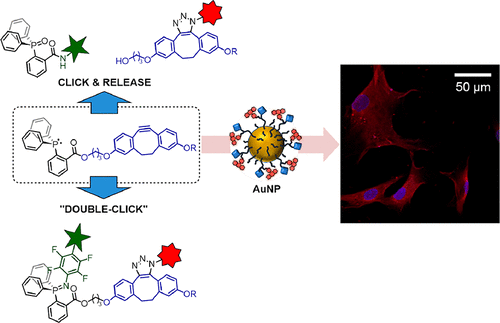当前位置:
X-MOL 学术
›
Bioconjugate Chem.
›
论文详情
Our official English website, www.x-mol.net, welcomes your
feedback! (Note: you will need to create a separate account there.)
Dual-Bioorthogonal Molecular Tool: "Click-to-Release" and "Double-Click" Reactivity on Small Molecules and Material Surfaces.
Bioconjugate Chemistry ( IF 4.0 ) Pub Date : 2019-03-14 , DOI: 10.1021/acs.bioconjchem.9b00078
Wilson Luo 1 , Johnny Luo 2, 3 , Vladimir V Popik 4 , Mark S Workentin 1
Bioconjugate Chemistry ( IF 4.0 ) Pub Date : 2019-03-14 , DOI: 10.1021/acs.bioconjchem.9b00078
Wilson Luo 1 , Johnny Luo 2, 3 , Vladimir V Popik 4 , Mark S Workentin 1
Affiliation

|
The development of reactive moieties that enable molecular control of bond-forming and bond-breaking reactions within complex media is highly important in materials and biomaterials research as it provides opportunities to carefully manipulate small molecules and material surfaces in a reliable manner. Despite recent advances in the realization of new ligation strategies and "click-and-release" systems, there has been little development of multifunctional moieties that feature a broad range of chemical capabilities. To address this challenge, we designed a molecular tool that can utilize four well-defined bioorthogonal chemistries interchangeably for the attachment, replacement, and release of molecules within a system: the Staudinger-Bertozzi ligation (SBL), perfluoroaryl azide Staudinger reaction (PFAA-SR), strain-promoted alkyne-azide cycloaddition (SPAAC), and strain-promoted alkyne-nitrone cycloaddition (SPANC). We demonstrate "click-to-release" and "double-click" reactivity on small molecules and gold nanoparticles (AuNPs) as a model material substrate. As a proof of concept for material derivatization, we employed 5 nm AuNPs-functionalized with a Rhodamine B derivative and biotin through the double-click strategy-and showed their potential as a pretargeted delivery nanocarrier. This multifunctional molecular tool enables the design and production of molecular and material systems with unique, modular, and tunable dynamic properties that can be altered under mild and bioorthogonal conditions.
中文翻译:

双生物正交分子工具:在小分子和材料表面上具有“单击释放”和“双击”反应性。
在分子和生物材料研究中,能够在复杂介质中实现分子控制键形成和键断裂反应的分子控制反应性部分的发展非常重要,因为它提供了以可靠的方式小心操作小分子和材料表面的机会。尽管最近在实现新的连接策略和“点击并释放”系统方面取得了进展,但是几乎没有开发出具有广泛化学功能的多功能部分。为了应对这一挑战,我们设计了一种分子工具,可以互换使用四种定义明确的生物正交化学方法来附着,置换和释放系统中的分子:施陶丁格-贝托兹结扎(SBL),全氟芳基叠氮化物施陶丁格反应(PFAA- SR),应变促进炔烃-叠氮环加成(SPAAC)和应变促进炔烃-硝酮环加成(SPANC)。我们展示了对小分子和作为模型材料基质的金纳米颗粒(AuNPs)的“单击释放”和“双击”反应性。作为材料衍生化概念的证明,我们通过双击策略采用了用罗丹明B衍生物和生物素进行功能化的5 nm AuNP,并显示了其作为预定的递送纳米载体的潜力。这款多功能分子工具能够设计和生产具有独特,模块化和可调动态特性的分子和材料系统,可以在温和的生物正交条件下对其进行更改。我们通过双击策略采用了用罗丹明B衍生物和生物素功能化的5 nm AuNPs,并显示了它们作为预靶向递送纳米载体的潜力。这款多功能分子工具能够设计和生产具有独特,模块化和可调动态特性的分子和材料系统,可以在温和的生物正交条件下对其进行更改。我们通过双击策略采用了用罗丹明B衍生物和生物素功能化的5 nm AuNPs,并显示了它们作为预靶向递送纳米载体的潜力。这款多功能分子工具能够设计和生产具有独特,模块化和可调动态特性的分子和材料系统,可以在温和的生物正交条件下对其进行更改。
更新日期:2019-02-26
中文翻译:

双生物正交分子工具:在小分子和材料表面上具有“单击释放”和“双击”反应性。
在分子和生物材料研究中,能够在复杂介质中实现分子控制键形成和键断裂反应的分子控制反应性部分的发展非常重要,因为它提供了以可靠的方式小心操作小分子和材料表面的机会。尽管最近在实现新的连接策略和“点击并释放”系统方面取得了进展,但是几乎没有开发出具有广泛化学功能的多功能部分。为了应对这一挑战,我们设计了一种分子工具,可以互换使用四种定义明确的生物正交化学方法来附着,置换和释放系统中的分子:施陶丁格-贝托兹结扎(SBL),全氟芳基叠氮化物施陶丁格反应(PFAA- SR),应变促进炔烃-叠氮环加成(SPAAC)和应变促进炔烃-硝酮环加成(SPANC)。我们展示了对小分子和作为模型材料基质的金纳米颗粒(AuNPs)的“单击释放”和“双击”反应性。作为材料衍生化概念的证明,我们通过双击策略采用了用罗丹明B衍生物和生物素进行功能化的5 nm AuNP,并显示了其作为预定的递送纳米载体的潜力。这款多功能分子工具能够设计和生产具有独特,模块化和可调动态特性的分子和材料系统,可以在温和的生物正交条件下对其进行更改。我们通过双击策略采用了用罗丹明B衍生物和生物素功能化的5 nm AuNPs,并显示了它们作为预靶向递送纳米载体的潜力。这款多功能分子工具能够设计和生产具有独特,模块化和可调动态特性的分子和材料系统,可以在温和的生物正交条件下对其进行更改。我们通过双击策略采用了用罗丹明B衍生物和生物素功能化的5 nm AuNPs,并显示了它们作为预靶向递送纳米载体的潜力。这款多功能分子工具能够设计和生产具有独特,模块化和可调动态特性的分子和材料系统,可以在温和的生物正交条件下对其进行更改。































 京公网安备 11010802027423号
京公网安备 11010802027423号